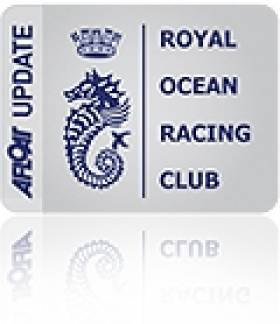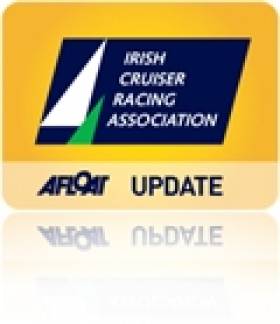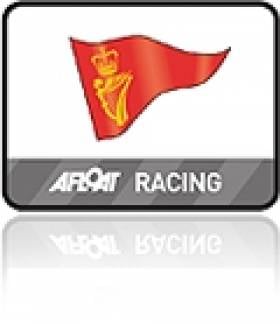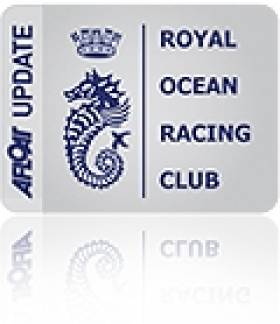Displaying items by tag: Anthony O'Leary
Mid Point Of The Regatta, Royal Cork is Sixth At Invitational Cup
Anthony O'Leary and his Royal Cork crew are sixth overall at New York Yacht Club's Invitational Cup. The first race of the day was won by RCYC, which O'Leary unfortunately followed with back-to-back double-digit finishes. They stand sixth overall with 49 points. There are some excellent aerial shots of Royal Cork very well positioned off the line in the above vid.
A day of intense racing on Rhode Island Sound marked the mid-point of the 2015 Rolex New York Yacht Club Invitational Cup. The south-south west breeze filled in early in the day, which allowed three races to be sailed in 8-10 knots by the international fleet. Like the standard of excellence established by Rolex, the competition has exceeded the expectations of the competitors.
Yesterday's subsequent races were both won by Australia's Middle Harbour Yacht Club, which bumped them up in the standings from eighth yesterday, to now second overall with 40 points. Returning to the top of the leaderboard is London's Royal Thames Yacht Club which consistently finished in the top-five. They have an eight-point cushion over Middle Harbour Yacht Club.
The racing was intense according to Brad Dellenbaugh, New York Yacht Club's Director of Sailing. "If you missed getting off the line and got forced to the wrong direction on the first beat, you spent the rest of the race trying to catch up. Occasionally one side or the other of the course was favored, but not the same side all the time."
Racing resumes Friday with the winning team determined at the conclusion of racing on Saturday, September 19.
Start Line Gap Credited With O'Leary's Second at New York Invitational Cup
Today's lone race favored the teams who were in the right place to strike and who were proficient in sailing in light air. Genoa, Italy, where the Yacht Club Italiano is based, is known for light breeze and, with Leonardo Ferragamo at the helm, the team parlayed that experience to win the race.
Second across the line was the Irish team representing Royal Cork Yacht Club. Skipper Anthony O'Leary, who has raced every edition of this event, credited finding a hole in the starting line with their performance in the race.
After two days, Seattle Yacht Club has taken over the top spot in the overall standings although it is tied on points (22) with Royal Thames Yacht Club. Royal Cork is third overall with 24 points, and Itchenor Sailing Club is fourth with 27 points. Three points back, tied at 30 points apiece, are Marblehead's Eastern Yacht Club and Toronto's Royal Canadian Yacht Club which is the two-time defending champion.
Racing resumes this morning with the winning team determined at the conclusion of racing on Saturday, September 19.
O'Leary's Embark on Fourth Rolex New York Yacht Club Invitational Cup Campaign
Royal Cork helmsman and Afloat Sailor of the Year Anthony O'Leary has assembled his crew for this week's Rolex New York Yacht Club Invitational Cup based on their performance on his winning Ker 40, Antix. A previous 5-8-4 record at this event indicates that while the Irish team infrequently sails one-design boats of the size of the Swan 42s used for the Invitational Cup, they are strong competitors within reach of the prize.
The first race is scheduled for 1100 each day starting tomorrow. Racing is scheduled to take place on Narragansett Bay, north of Gould Island, or on Rhode Island Sound, south of Brenton Point Park. The racing location will be picked each morning. The regatta is hosted out of the New York Yacht Club at Harbour Court.
It is a testament to the ideals of Corinthian competition, and the camaraderie associated with the sport that for the fourth edition of the Rolex New York Yacht Club Invitational Cup, six of the 17 entered yacht club teams will be welcomed back as four-time veterans of this highly-regarded event, including O'Leary's Irish team.
Hailing from all corners of the globe, the returning teams - Royal Hong Kong Yacht Club, the Japan Sailing Federation, Real Club Nautico de Barcelona (ESP), the Royal Yacht Squadron (GBR) and the two-time defending champion, the Royal Canadian Yacht Club - are drawn by the intensity of the on-the-water competition which is enhanced by notable social events held at Harbour Court, New York Yacht Club's iconic clubhouse overlooking Newport harbour.
The 2015 Rolex New York Yacht Club Invitational Cup welcomes competitors from the following yachts clubs: the Royal Yacht Squadron (GBR), Japan Sailing Federation (JPN), Real Club Nautico de Barcelona (ESP), Royal Canadian Yacht Club (CAN), Royal Cork Yacht Club (IRL), Royal Hong Kong Yacht Club (HKG), Royal Thames Yacht Club (GBR), Yacht Club Argentino (ARG), Yacht Club Italiano (ITA), Royal Prince Alfred Yacht Club (AUS), Royal Swedish Yacht Club (SWE), Eastern Yacht Club (USA), Itchenor Sailing Club (GBR), Middle Harbour Yacht Club (USA), Newport Harbour Yacht Club (USA), Seattle Yacht Club (USA) and New York Yacht Club (USA).
Antix Leading RORC's Myth of Malham Race
#rorc – Royal Cork's Anthony O'Leary at the helm of Antix rounded Eddystone Lighthouse this morning in RORC's 259–mile Myth of Malham Race. The Cork Harbour yacht is currently seven miles offshore at Salcombe. Unofficially, Antix is leading the 141 yacht fleet overall, after IRC time correction, and expected to finish the race tonight.
#commodorescup – The two managers behind both of Ireland's Commodore's Cup victories have 'stepped down' from the job, an executive meeting of the Irish Cruiser Racer Association (ICRA) heard last month. A successor for both Barry Rose of Royal Cork YC and Fintan Cairns of the Royal Irish YC is being sought by the cruiser–racer body to defend the international title next season on the Solent. The midlands meeting heard ICRA's shore management performed 'a very important role as a focal point and coordinator for the whole team process' .
It was imperative, according to the meeting, chaired by Howth YC's Nobby Reilly, that ICRA would continue to perform that role in the future. The Portlaoise gathering of April 20th also heard of the necessity to start the process of 'achieving team or team selection' to challenge in 2016. The quest for team sponsorship also needs to be underway.
Separately, Royal Cork's Commodore's Cup team captain Anthony O'Leary has told Afloat.ie of his 'fervent hope' to be involved with the 2016 defence of the Cup that he has won twice. However, his Ker 39, Antix has been sold to Sweden and this year O'Leary and his Antix crew are campaigning offshore in the renamed Ker 40, Catapult. They take in RORC's Myth Of Malham this week before June's Dun Laoghaire to Dingle race. They're both warm–up races for the season's big one in August, the sell–out Fastnet race.
The 2016 Commodore's Cup changes will see the reintroduction of a small boat for the team competition next year it has also been announced. The Royal Ocean Racing Club (RORC) has agreed to a number of changes that they say will have 'a positive impact' on the number of teams taking part in the event held at Cowes, Isle of Wight between 23 and 30 July 2016.
The first is the requirement of every team to have a small boat with a rating between 1.000 and 1.049. 'Many teams in the last event believed that it was hard to be competitive without having three boats that were close to the top of the allowable rating band, as was the case of last year's winning Irish team,' said RORC CEO, Eddie Warden Owen.
As the Irish Times Sailing Column reports, lowering the rating band to 1.000 will make it easier for J109s to enter, to include boats like the JPK10.10, A35 and the new Sunfast 3200, and reduce the cost of competing.
Read also: How Ireland won the Commodore's Cup and Anthony O'Leary, Sailor of the Year
#royalcork – Four years and seven months may seem an eternity for many people. Yet if you're in the business of planning major club and sporting events, particularly where there's a significant international context, then four years and seven months is but the blinking of an eye. In 2020 - in four years seven months and 22 days to be precise - the Royal Cork Yacht Club will be 300 years old. W M Nixon takes a look at life in and around a very remarkable and undoubtedly unique organisation as it moves steadily towards its special date with destiny.
The world's oldest yacht club is in good health, enjoying a growing membership with an increasing and very distinguished international flavour. And it already has a proven track record in marking significant birthdays. Back in 1969-70, led by Clayton Love Jnr as a visionary and energetic Admiral, the club celebrated its Quarter Millennium with a two year sailfest which included finishing a Transatlantic Race, starting or finishing several other major offshore races, staging several national and international championships, running a race week, and co-ordinating an especially successful Cruise-in-Company by a large fleet from Cork Harbour to Glengarriff on Bantry Bay.
In this galaxy of sailing events, the Royal Cork's traditions of volunteerism and competitive involvement afloat was much in evidence. If Crosshaven sailors weren't running the show afloat and ashore, then they were likely to be competing in it afloat, and almost inevitably featuring in the frame.
So in all, those staging the Quarter Millennium set a standard which their successors planning towards 2020 - which is additionally distorted by being an Olympic year - will find difficult to match. For they'll be doing so in a very changed world in which newly re-born regattas and special events are crowding the national and international calendar, while the undoubted international change of attitude in favour of events in warmer climates means that a sailing club on an island well north in the Atlantic will have to try that much harder to attract the kind of boats and sailors its major and unprecedented anniversary merits.
But far from being fazed by the prospect of what needs to be done for 2020, the Royal Cork YC relishes living life to the full in the here and now. During the past year and more, the Crosshaven club has been led with such enthusiasm and exemplary energy afloat and ashore by Admiral Pat Lyons that at the National Sailing Awards in Dublin in March, it was announced that the Royal Cork was the winner – for the sixth time - of the annual ISA/Mitsubishi Motors "Sailing Club of the Year" trophy, which dates back to 1979 but has been firmly under the wing of Mitsubishi Motors since 1986.
However, although the announcement was made at a national gathering, the essence of the Club of Year accolade is that the winning club and its members should be honoured in their own clubhouse in its own very specific local setting. Which sounds straightforward enough. But when you get into the world of high-powered sailing types and the challenge of trying to get many fast-moving targets into one place at the one time, it makes herding cats seem like a doddle. So it wasn't until this week that a date was finally found on which most of the key players in the Royal Cork scene would be in and around their clubhouse. But it was well worth the effort and the wait – the ceremony provided us with the very purest spirit of Royal Cork.

Crosshaven in high summer. Around Cork Harbour, the interaction between sea and land seems much more comfortable than anywhere else in Ireland. Photo: Robert Bateman

At this week's Club of the Year awards ceremony for the Royal Cork YC were (left to right) W M Nixon, (chairman of the adjudicators), David O'Brien (ISA Board Member), Pat Lyons (Admiral RCYC), Frank Keane (Chairman Mitsubishi Motors), and Billy Riordan (CEO Mitsubishi Motors). Photo: Robert Bateman
Such is the enthusiasm of this remarkable club at its immaculately-maintained and hospitable clubhouse/marina complex in Crosshaven that you'd think they must be one of the newest in the land. But they went at their sailing in 2014 as though it was Tricentenary time already, running a nine-month club sailing programme with an extensive junior training input, and in addition staging the ISAF Women's International Match Racing Worlds in June.
Then in July they hosted a successful Cork Week which – apart from providing great racing for all competitors – showcased the new Irish International Commodore's Cup Team for the first time, an auspicious debut as the team went on to win the Commodore's Cup, with Royal Cork's Anthony O'Leary playing a key role throughout.
Anthony O'Leary also won the British IRC Opens and the Irish Helmsmans Championship, and then for good measure he took the 1720 Nationals as well. Meanwhile, RCYC's Harry Durkan took the junior title, while clubmate Seafra Guilfoyle was garlanded with international success in the Lasers.
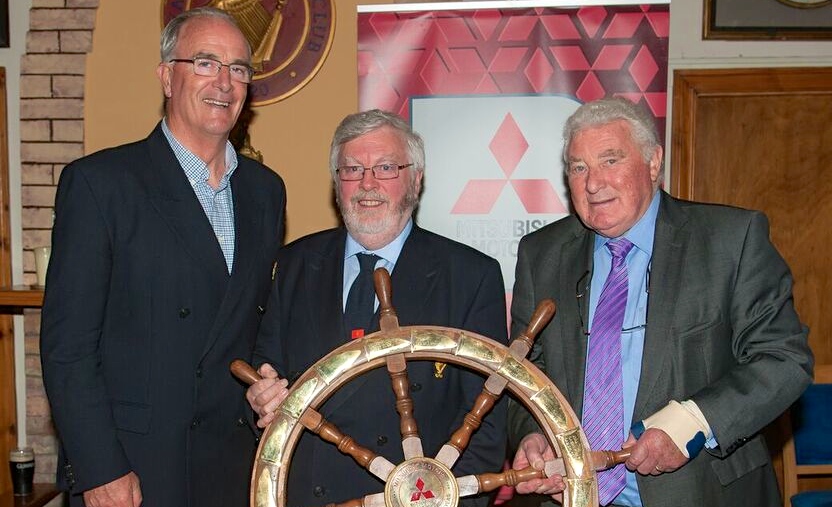
Commodore's Cup Team Captain and Afloat.ie Sailor of the Year 2014 Anthony O'Leary with RCYC Admiral Pat Lyons and Frank Keane of Mitsubishi Motors. Photo: Robert Bateman
On the cruising front, it was to be announced in due course that during 2014, the voyaging by Royal Cork YC longtime member Neil Hegarty in his 34ft sloop Shelduck on both sides of the Atlantic, and across it too, had been awarded the premier trophy of the Irish Cruising Club, the Faulkner Cup. As it happens, the skipper of Shelduck was one of the few conspicuous absentees from this week's ceremony, for the very good reason that he's already away cruising in America. But the ICC was well represented by Vice Commodore Dan Cross of Crosshaven, and also by former RCYC Admiral Paddy McGlade, who in 2014 organised the Cruising Club's very successful 85th Anniversary Cruise-in-Company from Crosshaven to Glengarriff with an exemplary lightness of touch.
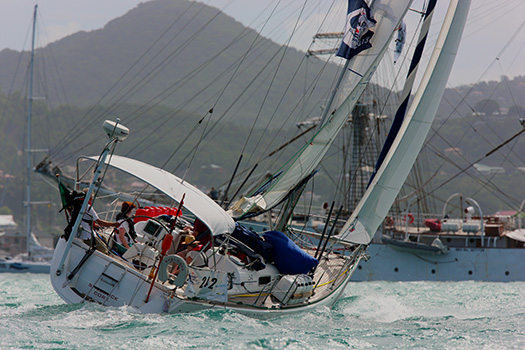
Neil Hegarty of RCYC bringing his Dufour 34 Shelduck into port at the conclusion of a Transatlantic passage during his award-wnning 2014 cruise.
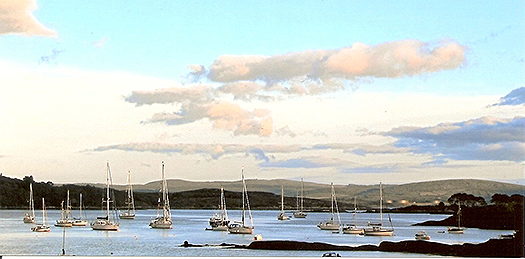
Part of the Irish Cruising Club's fleet in Glengarriff during the Cruise-in-Company organised by Royal Cork's Paddy McGlade

Odyssey, the prototype of the new National 18 whose development has been largely driven by the Cork Harbour division of the class.
Back home meantime, the Royal Cork's busy and long-established fleet of National 18s played the key role in developing the new National 18 which is currently being launched to popular acclaim, and two of the key figures in what amounts to a remarkable community movement – Dom Long and Tom Dwyer – were enthusing, and quite rightly too, about the new boats in the RCYC at this week's gathering.
At the height of the season, the Royal Cork was one of the clubs leading the movement in putting new life back into the established two-person dinghy classes. And looking to the future this summer, the club's plan to revive Dinghy Week as a four day event in August already shows every sign of success, emphasising the presence of an ongoing sense of the continuity of Cork Harbour sailing, something which in its turn is reinforced by a healthy and dynamic interaction with the community within which this great club is set.
There is no doubt that Cork is different. It interacts with the sea in a much more comfortable way than anywhere else in Ireland, and boats are everywhere about Cork harbour, whether nestling in a mudberth, or lying to a sheltered mooring, or berthed in one of the sparkling new marinas which seem to be springing up in every part of the harbour as the economy gets going again.
As for trying to capture the essence of the Royal Cork, the fact that the Club of the Year trophy adjudication force us to take a still from a moving film – often a very fast-moving film – only serves to emphasise how successful the RCYC is at so many levels.
Thus its exceptional successes in 2014 have now been clarified in proper order and full detail. But already they've moved well into 2015. Cork sailors were very much to the forefront in the recent major Laser event on Lough Erne, with young Nicholas Walsh the pace-setter. And of course the indefatigable Anthony O'Leary is already the Afloat.ie "Sailor of the Month" for April after his clean run of success with the new Ker 40 Antix, ex-Catapult, in the Solent.

Party time in the Royal Cork after the formal presentation ceremony. The trio at right are ICC Vice Commodore Dan Cross and Sally and Anthony O'Leary. In classic Crosshaven style, Dan and Anthony have been friends and neighbours ashore and afloat since childhood. Photo W M Nixon
He finds her a fascinating boat after his more conservative Ker 39, the silver Antix of 2006 vintage. Whereas the older boat was quite docile to steer, as she had twin wheels complete with footbrace pads for the helmsman, the new boat is more like a giant dinghy with a widow-maker of a tiller, and the helmsman having to be hyper-fit to keep himself in place on that very wide cockpit. The word from Skipper O'Leary is that the red Antix is a dream to helm to windward, but steering her on a hairy run can be....well, very hairy indeed.
That such things could be discussed with the man himself was all of a piece with the remarkable mood in the Royal Cork Yacht Club, where the conversation turned with equal ease to the new Cool Route. This is the cruising trail from southwest Ireland to northern Norway which is being developed in Cork Institute of Technology by RCYC member John McAleer with the club very much on board as an international marketing partner.
As to just how this will go, we can only think for now that if they could just somehow bottle the communal can-do spirit of the Royal Cork and then get it to work its magic in all the other prospective ports along the Cool Route, then they really would have a winner. Meanwhile, congratulations to the Royal Cork Yacht Club, ISA/Mitsubishi Motors Sailing Club of the Year for 2015.
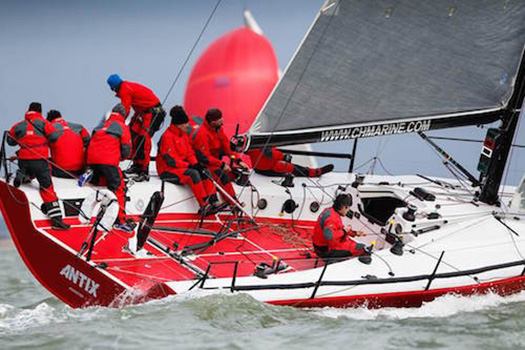
A different animal altogether. After the compact and comfortable two-wheel arrangement on the silver veteran Ker 39 Antix , the new tiller-steered Ker 40 Antix may provide a more direct feedback sailing on the wind for helmsman Anthony O'Leary, but hectic downwind sailing can become very hairy indeed.
#sailorofthemonth – Current "Sailor of the Year" Anthony O'Leary of Royal Cork YC has started his 2015 season in winning style by book-ending April with a runaway overall victory in the RORC Easter Challenge in the Solent from April 3rd to 5th as the new month got under way, and then rounding it out with a convincing win in the Brooks Macdonald Warsash Spring Championship, a twelve race series which concluded on Sunday April 26th.
O'Leary's new mount is yet another Antix, but this time she's the unmistakably red state-of-the-art Ker 40 which was formerly Catapult, key member of Ireland's winning 2014 Commodore's Cup Team, in which she was also the top individual points scorer.
In classic O'Leary style, the team debut with the new Antix at Easter was a low-key affair. At the conclusion of the series, some might have expected to witness a close-knit disciplined group in some sort of uniform as the winning crew assembled outside the RORC's new Cowes base at the former Royal Corinthian clubhouse. Instead, they saw what seemed like a bunch of mates of many ages who could have been casually assembled from the RCYC waterfront and taken to the Solent for a bit of light-hearted Easter sport.
But the results speak for themselves, and by the end of the month, the remarkable new Antix with her very dished stern was being sailed as though the crew had been with her for at least a year. And their skipper was particularly enthusiastic in his praise for the foredeck duo of Dylan Gannon and Jamie Donegan, "whose performance had been faultless throughout the Brooks Macdonald regatta". But in the end, it is Anthony O'Leary's sure touch in assembling a talented crew and sailing a boat to perfection which makes him a very worthy "Sailor of the Month" for April.

The new Ker 40 Antix with Anthony OLeary at the helm in the RORC Easter Challenge. The exceptionally dished shape of the stern makes her markedly different from his previous Ker 39, the veteran silver Antix
Royal Cork's Antix Wins Warsash Spring Championships
#royalcork – Cork harbour yacht Antix took the 2015 Brooks Macdonald Warsash Spring Championship on the Solent today with an excellent performance in what were very challenging conditions writes Claire Bateman.
Finishing the series with two first place finishes today Antix won the twelve race, no discard, series by 6 points from Mike Bartholomews team aboard "Tokoloshe" with Simon Henning third in "Alice".
Racing today took place in a 12 knot North Easterly and both races were incredibly close.
Antix took the first race by 32 seconds from Tokoloshe after a 1 hr 40 minute race during which the lead changed on a number of occasions and Race 2 was even closer with Antix the first of four boats that finished within 26 seconds of one another on corrected time.
Skipper Anthony O'Leary praised the Antix crew and in particular the bow team of Dylan Gannon and Jamie Donegan whose performance was "faultless throughout the regatta."
Results Brooks Macdonald Warsash Spring Series
IRC1: Antix (Anthony O'Leary)
IRC2: Salvo (Peter Morton - JND 35)
IRC3: Malice (Mike Moxley - Hod 35)
IRC4: Crakajax (Richard & Ursula Hollis)
J109: Jagerbomb (Paul Griffiths)
J70: Little Louise (Jamie Arnell)
J80: Betty (Jon Powell)
SB20: F5 Synthesis (Pieter Heyn)
Results Brooks Macdonald Crewsaver Spring Championship
IRC1: Antix (Anthony O'Leary)
IRC2: Raygun (Mark Devereaux)
IRC3: Malice (Mike Moxley - Hod 35)
IRC4: Umzingeli (Ralph Mason)
J109: Jacobi (Ivan Burden)
J111: Jitterbug: (Cornel Riklin)
J88: Eat, Sleep,J, Repeat (Paul Ward)
Quarter Ton: Aguila (Sam Laidlaw)
Sigma 38: Pavlova III (Max Walker)
J70: Boats.com (Ian Atkins)
J80: Betty (Jon Powell)
SB20: F5 Synthesis (Pieter Heyn)
#cruiserracing – Can you successfully incorporate a full-blown National Championship into an established neighbourhood regatta? We're going to find out from June 24th to 27th, when the ICRA Nationals and the Sovereigns Cup in Kinsale are combined into one four day event, the result of the joint efforts of two sets of organisers and administrators. W M Nixon takes a look at how this situation has developed and discovers four of the top men in the marine and sailing scene have significantly different views as to how big regattas and the ICRA Nationals should be staged.
The Irish Cruiser-Racer Association emerged from an attitude of complete realism about the contemporary sailing scene in 2002. Back then, the Irish economy was starting to develop a head of steam, and people were buying potent performance-cruisers which just begged to be raced offshore. Yet changing social attitudes meant that the traditional concept of an offshore racing crew being prepared to spend seven or eight long weekends away every summer campaigning the boat in classic offshore races simply wasn't acceptable in the new world of shared family responsibilities.
But the short-lived ideal of making classic offshore racing more family-friendly was also soon seen as unattainable except for those few extra special family crews – we can all think of one or two examples - whose very uniqueness in their shared enthusiasm for rugged offshore sailing day and night only serves to emphasise that what they like doing is simply not for the majority of sailing families.
For sure, we admire them without reservation. But we know that it won't float our family's boat. For although the totality of Irish "cruiser-racers" in 2002 included several out-and-out racing machines which were vigorously campaigned inshore and offshore, the reality is that most of the fleet were the sailing equivalent of those 4x4 SUVs which block up the parking in many a leafy and affluent suburb.
Usually, the most adventurous outing such vehicles will go on is the daily school run. There's no way their loving owners plan an aggressive demonstration of their pride-and-joys supposed off-road ability. But they do seem to find it reassuring to know that if for some reason they suddenly have to go across rough terrain, the vehicle can manage it even if the driver is scared stiff. And of course, in the unlikely event that a horse-box needs to be towed – well, no problem......
So, thirteen years ago as sailing's equivalent of the SUV began to take over marinas, two leading figures in sailing administration realised that, far from changing the new increasingly family-oriented way of doing things and forcing boats well capable of going offshore to do so even if their crews didn't particularly want to, what was needed instead was a new kind of event to suit the way that most people wanted to sail with their new performance cruisers.
The late Jim Donegan of Cork, Commodore of the South Coast Offshore Racing Association, was ocean racing aristocracy – his grandfather Harry owner-skippered the 18-ton cutter Gull to third place overall in the first Fastnet Race in 1925, and consequently became one of the founder members of the Ocean Racing Club which six years later in 1931 became the RORC, while Jim himself was to go on to win many an offshore contest.
Fintan Cairns of Dun Laoghaire has given generously of his energy and time over the years to sailing both as an active participant, a race officer, and an administrator – he was Commodore of Dublin Bay Sailing Club at a period of its healthiest expansion. Like Jim Donegan, in 2002 he was hugely enthusiastic about racing boats with lids, and he loved the offshore game. Yet in the Autumn of 2002, the two of them convened a national assembly in Kilkenny in order to form an organization whose primary aim would be to create the kind of event that would be attractive to the new generation of cruiser-racer owners, people whose boats could go offshore, but preferred the nice regatta atmosphere and home-to-port-at-the-end-of-the-day format.

A nice regatta atmosphere, and back to port at the end of the day.....the racing in the ICRA Nationals 2014 at the Royal Irish YC in Dun Laoghaire neatly captures the purpose of the organisation as envisaged by the founders in 2002. Photo: David O'Brien
Thirty-one years earlier in 1971, the Irish Sea Offshore Racing Association had been formed by enthusiasts like Hal Sisk of Dun Laoghaire and Dickie Richardson of Holyhead on the assumption that their new organisation should be related to an area of good and extensive racing water, and for a while it worked very well. At its peak, ISORA was attracting a total entry of 107 different boats from all arts and parts into their annual season-long championship in which – if you were intending to be a serious contender – you had to think of racing at least seven events.
That meant seven weekends which, in some cases, inevitably meant leaving your home port on the Thursday and maybe not getting back until Monday morning or even later. Fine and dandy in its day, but its day didn't last too long. Maybe fifteen years in all. By then, new attitudes to family life and a tendency to concentrate one's sailing on a few big events combined with other less time-consuming smaller local events, meant that the ISORA model was no longer valid.
Yet boat numbers in ports kept increasing, so the Irish Cruiser Racing Association came into being at that November meeting in Kilkenny in 2002 to provide Irish-based regattas which, in some cases, would involve trailing the smaller boats to distant venues still on the island of Ireland, instead of sailing them many miles to others ports across the channel.
For old salts, the idea of an offshore racing association based on a land mass, and the notion of road-trailing offshore racers across that land mass to a regatta, seemed absurd. But this was only the beginning of it. For unless there was an unexpected demand for it, the new ICRA programme had no plans to include any overnight sailing except where it involved the training up an Irish Commodore's Cup team, as this was soon within ICRA's ambit.
Basically, what it meant was that ICRA's purpose was to organize an annual national championship regatta of four days at one of Ireland's main sailing centres, chosen on a rotational basis, they would also honour a "Boat of the Year", and every second year they would assemble a Commodore's Cup team.
Far from owners being faced, as they were in the old days, with the challenging demands of preparing a boat for offshore racing and then assembling an experienced crew from a panel in which the ideal number would be twice the number required to crew the boat, instead they were now offered an agreeable pattern of day sailing at some pleasant venue, and much socialising with it, while the results were efficiently calculated by ICRA's travelling road show of race administrators and number crunchers.
Yet for anyone who thought this wasn't really quite rugged enough, there was ruggedness-by-association with the Commodore's Cup campaigns. And all this went particularly well as the Irish economy went stratospheric from 2002 until 2008, so much so that at one stage Ireland actually fielded three different Commodore's Cup teams which even had the luxury of competing against each other. There's posh for you......
But it was too good to last, and ironically the economy had already fallen off a cliff in 2010 when a very serious single team Irish Commodore's Cup campaign, carefully led by Anthony O'Leary, finally won the Commodore's Cup. Also during 2010, the ICRA Nationals in late May were hosted by the Royal St George YC in Dublin Bay, which provided immediate access to the largest fleet of cruiser-racers in Ireland. Thus numbers were easily kept up to a respectable level and in all – the brutal recession notwithstanding – it was a great year for ICRA, with the 2010 Commodore Barry Rose, who had also been the Commodore's Cup Team Manager, deservedly accepting the Mitsubishi Motors "Irish Sailing Club of the Year" award after this great season.
But inevitably, things were more subdued for the next three years as the longterm ill-effects of the recession took hold. So though ICRA Nats were held in Crosshaven in 2011, Howth in 2012, and Fenit on Tralee Bay in 2013, resources were so scarce that the decision was taken not to attempt a defence of the Commodore's Cup in 2012.

The images which came back from the ICRA Nationals 2013 in Tralee Bay suggested good sailing, but for two days the stormy weather caused a complete shut-down. Photo: Bob Bateman
When one cornerstone is removed, others are examined in more detail. The 2013 ICRA Nationals in Tralee Bay had the misfortune to coincide with a period of very unsettled weather which emphasised the fact that many of the top boats had travelled a long way by both sea and land to this gallant outpost of the Irish offshore racing scene to link up with their WIORA counterparts. But although some spectacularly sunny photos of racing in strong winds and bright sunshine emerged, the reality is that they barely had two days of viable competition as the rest of the programme was blown out in utterly miserable storm conditions.
Coming as it did at a time when the economy was barely faltering back into life, this unlucky outcome led to it being open season for suggestions as to the way ahead. There were those who wondered if people's seemingly ever-decreasing sailing time might be better used if the ICRA Nationals were combined into some established events, pointing out that a natural annual rhythm was already there with the biennial Volvo Cork Week rotating with the biennial Volvo Dun Laoghaire Regatta to provide easy access for large local fleets.
When set against the all-Ireland idealism of the founders, this was anathema to many, as the stand-alone national event, with the effort made to go anywhere in Ireland where you could find substantial local cruiser-racer fleets, was seen by some as central to the ICRA ethos.
However, things were put on hold during 2014 with a well-supported if locally-emphasised ICRA Nationals hosted by the Royal Irish YC in Dublin Bay in June, and then in July there was a mighty victory in the Commodore's Cup 2014 in a wonderful effort built around quiet background work by team captain Anthony O'Leary.
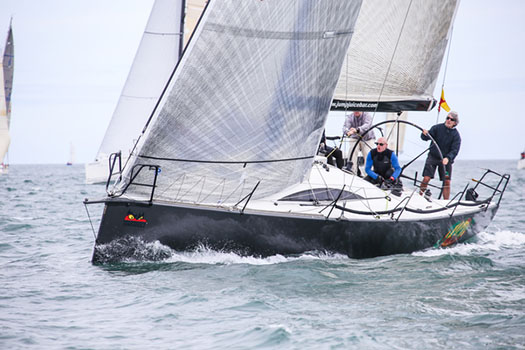
ICRA Nats 2014 in Dublin Bay saw a popular win in Class 0 for the Phelan family's Ker 36 Jump Juice from Crosshaven. Photo: David O'Brien
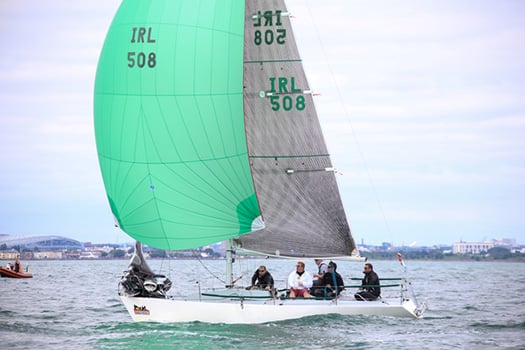
Jonathan Skerritt's vintage Quarter Tonner Quest of the host club was overall winner of the ICRA Nats 2014 at the RIYC. Photo: David O'Brien
But meanwhile, faced with the reality of the recession in sailing, ICRA's senior number cruncher Denis Kiely had quietly been putting out feelers about the possibility of combining the 2015 ICRA Nationals with Kinsale YC's biennial Sovereigns Cup regatta, which has been trundling along since 1995. By the time the great 2014 season was fully under way, it was no secret that this arrangement for 2015 was already in place, thereby guaranteeing – it was hoped – a substantial increase in numbers in 2015 and better overall value for the sailing community, while at the same time taking the ICRA Nationals to another new venue.

The perfect sailing in the 2013 Sovereign's Cup at Kinsale inspired ICRA officers to seek the link-up for the ICRA Nationals 2015 with the Sovereigns Cup 2015. Photo: Bob Bateman
At first glance, it seemed eminently sensible. But not everyone agreed. It was towards the end of an engaging interview with Commodore's Cup winner Anthony O'Leary at the end of July last summer in his beloved Royal Cork YC, just four days after he and his team had received the trophy on behalf of Ireland on the Royal Yacht Squadron lawns in Cowes, that I witnessed the first significant shot going across the bows of the good ship ICRA/Sovereigns of Kinsale.

Team Captain Anthony O'Leary's veteran Ker 39 Antix hanging in there to stay ahead of a newer Ker 40 to lead Ireland to victory in the 2014 Commodore's Cup. Photo: Rick Tomlinson
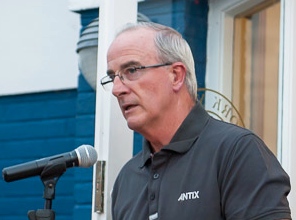
Someone whose considered opinion has to be taken seriously – Anthony O'Leary in thoughtful mood as he speaks at a reception to welcome the Commodore's Cup back to the Royal Cork YC. Photo: Bob Bateman
Anthony O'Leary was quite clear in his mind as to how the Irish cruiser-racing scene should go forward. And just as you should never get into a row with people who buy ink by the barrel, equally you wouldn't dream of openly disagreeing with someone who has just pulled Irish sailing out of the doldrums, so I just sat still and let this broadside roll over me.
"I think it's a mistake to incorporate the ICRA Nationals in the Sovereigns Cup in Kinsale....." he said bluntly. "The Sovereigns is one of my favourite regattas, but it's a friendly intimate business. While the town may have the infrastructure ashore, the marina is always crowded and I don't see how the kind of fleet they hope to attract will be comfortably accommodated there".
"Then too" he continued, "we already have two major alternating four day regattas in Dun Laoghaire and Cork Harbour. It's time to accept that sailing people are seeking to focus on fewer major events, and to give a more compact annual programme their best shot. So let's see how it would work if the ICRA Nationals simply rotated between Volvo Cork Week and the Volvo Dun Laoghaire Regatta".
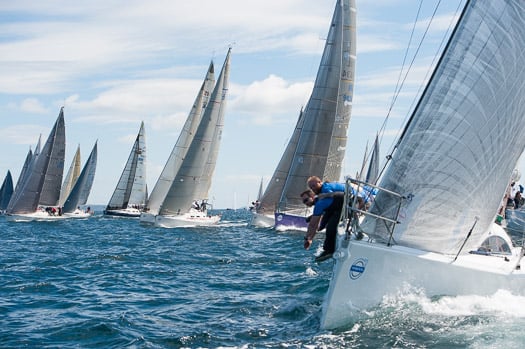
Clean close racing at Volvo Cork Week 2014. There's a line of thought that reckons this regatta could comfortably incorporate the ICRA Nationals. Photo: Bob Bateman
You can see how, in the circumstances, this idea seemed vibrant and immediately attractive. But more recently in an interview with another equally renowned sailor, Tim Goodbody who is Chairman of the Volvo Dun Laoghaire Regatta Committee 2015 there was something said which gave further pause for thought.
Tim Goodbody was totally clear in his own mind about the thinking behind the successful VDLR concept and its ability to provide viable racing for 31 different classes, and as he has helmed to victory both inshore and offshore to the highest levels, while also proving himself a master at designing courses for Dublin Bay, his views carry every bit as much weight as those of Anthony O'Leary.
"You have to remember it's a regatta, not a championship" said Goodbody. "Enjoyment of sport comes first, and the purity of fierce competition second. But of course we're going to provide the best possible starts. And the intention is to have those starts leading into the best possible courses in the conditions prevailing"
"Yet the way we see it, people should be racing just as soon as possible after leaving the harbour. There's nothing which impairs simple sailing enjoyment so much as having to wait around in a perfectly good but maybe fickle sailing breeze, hanging about in frustration while an overly-pernickety Race Officer dithers over setting the absolutely perfect start line".
In the context of the fun-filled suburban sailfest which is the VDLR, that's a perfectly reasonable approach. But is it a proper approach for something which aspires to call itself a National Championship? I rather doubt it, and there's no way the VDLR claims to be a national championship even if the numerous GP 14 Class are calling their enthusiastic participation in the VDLR 2015 the class's "Leinster Championship".

Everyone getting in everyone else's way, but that's part of the fun. The laid-back approach of the Volvo Dun Laoghaire Regatta as seen at 2013's event. Photo VDLR
For, in terms of boat size, the GP 14s will be among the smaller craft taking part in the VDLR, and they can find their own space. However, if you were campaigning a large cruiser-racer in one of the ten IRC classes which have to share the waters of Dublin Bay with 21 other boat classes during VDLR, would you expect to have your part of the event designated as the ICRA Nationals? On the contrary, if you were seriously concerned about the overall good of Irish sailing, you'd probably rightly think this was a spurious claim for what is essentially a fun event.
We were still mulling over the deeper meaning of Tim Goodbody's words in relation to Anthony O'Leary's opinions when this week another big beast in the sailing sphere, Minister for the Marine Simon Coveney no less, also launched into the choppy waters to be met with by those who would hope to rationalise the sailing programme into fewer but bigger international-standard events.
As he was speaking aboard the Naval Service's LE Eithne in Dublin's River Liffey at a reception to boost this summer's joint ICRA Nationals/Sovereigns event in Kinsale, it will be no surprise to learn that he was strongly in favour of it, so perhaps he reckons – unlike Anthony O'Leary - that Kinsale can cope with a substantial influx of visiting boats.
"Two events like this combined at the same time in one venue give extra strength" he said. "I want to see sailing in Ireland become much more ambitious in combining resources to create events which will have true international standing. This is a sport we should be really good at, both in participation and in staging events of world stature. Combining medium-sized events and regattas into one much bigger event like this one in Kinsale is going to be for the long-term good of Irish sailing in particular, and Ireland in general. The planned event is now expected to generate at least €800,000 extra income for the Kinsale area during the regatta period, while there's continuing beneficial spinoff for this harbour town which has added significance as the southern terminal and start point for the Wild Atlantic Way".
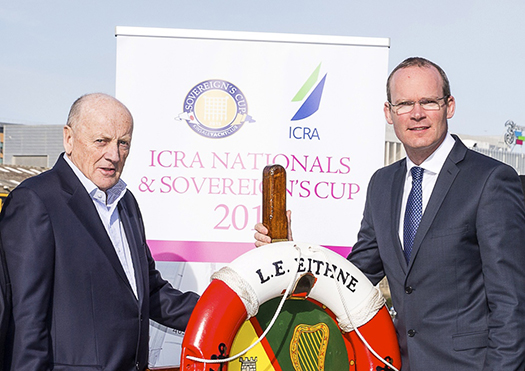
Norbert Reilly, Commodore of ICRA, with Minister for the Marine Simon Coveney at this week's reception aboard LE Eithne in Dublin to promote the combined ICRA Nats and Sovereigns Cup 2015 at Kinsale from 24th to 27th June. Photo: David Branigan
Doubtless we'll be getting spinoff of a different kind about these Ministerial views from the many people around the coast who work long and hard to keep alive those quirky little local regattas and special neighbourhood sailing and boating events which will never be major happenings of international stature, but are an essential part of the fabric of our many and varied maritime communities, and are deeply attractive for discerning visitor who shun crowds and seek out quiet enjoyment.
But as it is, aboard the Eithne we had yet another viewpoint to put into the cauldron of developing opinion, as the concluding speech was made by Nobby Reilly, current Commodore of ICRA. In a conversation with him before he made his speech, Nobby emphasised that the ICRA Nationals 2016 will be a stand-alone event once more, and he can be fairly certain about that, as the venue will be his own home port of Howth.
In the light of this, it should be remembered that in his blunt no-nonsense way, Nobby has done great work in encouraging newcomers into sailing. Earlier this week, I happened to be with some keen sailing folk from Wicklow including David Ryan – Farmer Ryan - whose remarkable Monster Project campaign of racing a Volvo 70 in Wicklow's Round Ireland Race 2014 had drawn on the efforts of Nobby Reilly and ICRA with their Let's Try Sailing campaign last May. This resulted in four wannabe sailors from remote parts of Ireland getting their first taste of the heavy metal with the Monster, and we'll see a film of it on RTE and other channels in due course, after the heroic task of cutting 147 hours of tape down to one hour has been completed.
But in the meantime, Nobby concluded the shipboard reception for this year's ICRA Nationals-with-the-Sovereigns-in-Kinsale with a spot of unexpected banter. "Maybe" says he, "maybe we should stop being concerned about trying to convince people that sailing is inexpensive. For we all know that, as it's a vehicle sport, there's bound to be basic expenditure over and above what you'd get with straightforward athletics and team sports. So maybe we should encourage people to get their kids to take up sailing on the grounds that if they come to like it, then there's no way they'll have the money to do drugs....."
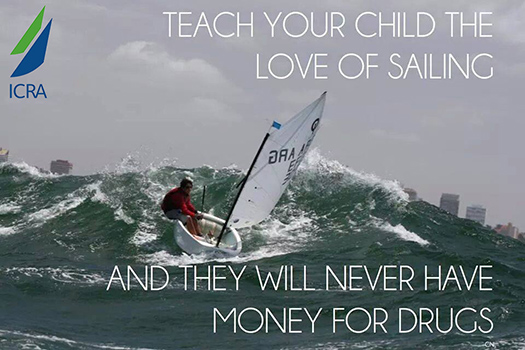
ICRA Commodore Nobby Reilly's positive response to the perceived costliness of sailing
Read also:
Should Irish Cruiser Racing (ICRA) Championships Stand Alone? (July 2013)
The Commodores' Cup – How Ireland Won It & Where It Might Go From Here (August 2014)
Royal Cork's Turbo–Charged Antix Wins RORC Easter Challenge
#antix – Winner of IRC One was once again Anthony O'Leary's Antix in today's conclusion of RORC's Easter Challenge writes James Boyd. However this year the Irish team faced a new challenge having exchanged their beloved silver hulled Ker 39 - which has twice taken them to Brewin Dolphin Commodores' Cup victory - for Marc Glimcher's red-hulled Catapult, the 'big boat' in their winning team last year.
The turboed Ker 40 is an asymmetric boat, a significant change from the previous Antix observed O'Leary: "It is completely different, but we have been sailing smaller asymmetric boats, the 1720s, for a long time. It goes around the track a lot faster, especially downwind."
Fortunately some of the Antix regular crew, including O'Leary's Olympic Star sailor son Peter, raced on Catapult last year and were able to show Dad the ropes.
"Yesterday it was exciting, great fun to get four races and we had plenty of competition from Tokoloshe and Baraka," continued O'Leary. "In Class One there seems to be more fast 40s than the previous generation boats now." The new Antix has a full season ahead, culminating in the Rolex Fastnet Race.
While the sun came out for the final day of the RORC Easter Challenge, sadly the wind failed to materialise on the Solent and at 1130 BST, Principal Race Office Stuart Childerley hoisted the AP over A announcing an end to the regatta
Fortunately the RORC Easter Challenge is a 'coaching regatta' and good use was made of the lost time at the RORC Cowes Clubhouse where Jim Saltonstall's seminar on the Racing Rules of Sailing was delivered to another packed house.
The prizegiving followed, held outside on the Club's terrace where the main silverware was presented, along with a considerable tonnage of Easter eggs.
Surprisingly, IRC Two was won by a 20 year old Mumm 36, albeit one that has been much tweaked and 'IRC-ed' along the way, including the fitting of a swept-back spreader rig. Simon Henning and his crew from Guernsey on Alice are regulars at the RORC Easter Challenge and this weekend beat Peter Morton's JND 35, Salvo to class honours.
"Yesterday was quite difficult, very shifty and up and down, so it was quite hard and I was getting shouted at a lot by my son Mike who does the tactics!" recalled Henning. While disappointed not to race today, the Alice crew enjoyed the elite level coaching from Jim Saltonstall and the North U Regatta Services double act of Chuck Allen and Andreas Josenhan.
"It is very interesting to hear what these guys have to say," said Henning. "It rakes old memories and reminds you about things you should be thinking about."
A similar stand-out performer was David Franks' IRC Nationals-winning JPK 10.10, Strait Dealer, which claimed three bullets and two seconds to win IRC Three.
Strait Dealer's performance was all the more remarkable because they were 'on course side' and forced to restart in two races.
"We managed to fight our way back which we were pleased about," admitted Franks. "We had some great sailors on board including Graham Sunderland of Winning Tides fame and another legend of the Solent, David Bedford, plus some very talented amateur sailors from the Etchells.
"The coaching was terrific. North Sails do a fantastic job and it is very good with the video and there's Stuart as PRO, giving his take on things and why he has done things, which was very interesting. And in the downtime today we had some really good conversation about rules at quite a high level.
"It has been a great warm-up and it is lovely to be in the new Club: I think this merger has been a huge success, helping both clubs to be that much better."
Finally, IRC Four was claimed by Sam Laidlaw's Quarter Tonner, Aguila ahead of David Lees' High Tension 36, Hephzibah.
CEO of the Royal Ocean Racing Club, Eddie Warden Owen was particularly pleased at how the integration with the new Clubhouse has gone.
"This is the first event that we have done at the new Clubhouse and it has been a great success. I think everyone loves the idea that the RORC has a home in Cowes and all the sailors have made a big effort to come here and enjoy the facility. The atmosphere has been very different to before, because we've never really had a home. It is nice to see everyone together.
"This morning we delayed the start and we were very surprised to see how many people turned up to listen to Jim and the coaching team, who have done a brilliant job. I think that the relationship with North Sails and Chuck and AJ - the guys they bring in from America - with all their experience, has stepped this regatta up to another level.
"It has been a very successful weekend and I think everyone has enjoyed it."




























